| Revision as of 18:57, 5 March 2018 view sourceArsi786 (talk | contribs)1,963 edits Wrong information correctedTag: Visual edit← Previous edit | Revision as of 22:35, 6 March 2018 view source Maximajorian Viridio (talk | contribs)Extended confirmed users13,604 edits →Kanem-Bornu EmpireNext edit → | ||
| Line 119: | Line 119: | ||
| ==== Kanem-Bornu Empire ==== | ==== Kanem-Bornu Empire ==== | ||
| {{Main|Kanem-Bornu Empire}} | {{Main|Kanem-Bornu Empire}} | ||
| The Kanem-Bornu Empire was an empire that existed in modern-day Chad, Nigeria, Cameroon, Niger and Libya. The empire first existed and prospered as the Kanem Empire as early as the 9th century and later as the |
The Kanem-Bornu Empire was an empire that existed in modern-day Chad, Nigeria, Cameroon, Niger and Libya. The empire first existed and prospered as the ] as early as the 9th century and later as the Kingdom of Bornu until 1900. | ||
| === French Niger (1900–58) === | === French Niger (1900–58) === | ||
Revision as of 22:35, 6 March 2018
For other uses, see Niger (disambiguation).Template:Distinguish2 16°N 8°E / 16°N 8°E / 16; 8
Republic of the Niger
| |
|---|---|
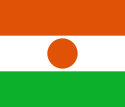 Flag
Flag
 Coat of arms
Coat of arms
| |
Motto:
| |
| Anthem: La Nigérienne | |
 Location of Niger (dark green) Location of Niger (dark green) | |
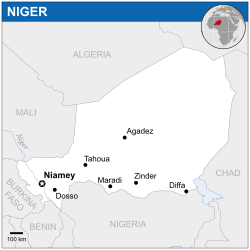 | |
| Capitaland largest city | Niamey 13°32′N 2°05′E / 13.533°N 2.083°E / 13.533; 2.083 |
| Official languages | French |
| National languages | |
| Demonym(s) | Nigerien /niːˈʒɛriən/ |
| Government | Unitary semi-presidential republic |
| • President | Mahamadou Issoufou |
| • Prime Minister | Brigi Rafini |
| Legislature | National Assembly |
| Independence from France | |
| • Declared | 3 August 1960 |
| Area | |
| • Total | 1,267,000 km (489,000 sq mi) (21st) |
| • Water (%) | 0.02 |
| Population | |
| • 2021 estimate | 25,252,722 (61st) |
| • 2012 census | 17,138,707 |
| • Density | 12.1/km (31.3/sq mi) |
| GDP (PPP) | 2017 estimate |
| • Total | $21.742 billion |
| • Per capita | $1,159 |
| GDP (nominal) | 2017 estimate |
| • Total | $8.141 billion |
| • Per capita | $434 |
| Gini (2011) | 31.5 medium inequality |
| HDI (2015) | low (187th) |
| Currency | West African CFA franc (XOF) |
| Time zone | UTC+1 (WAT) |
| Drives on | Right |
| Calling code | +227 |
| ISO 3166 code | NE |
| Internet TLD | .ne |
| |
Niger, also called the Niger (/ˈnaɪdʒər/ , or /niːˈʒɛər/; Template:IPA-fr) officially the Republic of the Niger, is a landlocked country in Western Africa named after the Niger River. Niger is bordered by Libya to the northeast, Chad to the east, Nigeria and Benin to the south, Burkina Faso and Mali to the west, and Algeria to the northwest. Niger covers a land area of almost 1,270,000 km, making it the largest country in West Africa. Over 80% of its land area lies in the Sahara Desert. The country's predominantly Islamic population of about 25 million mostly clusters in the far south and west of the country. The capital city is Niamey, located in Niger’s southwest corner.
Niger is a developing country, consistently ranks near the bottom in the United Nations' Human Development Index (HDI); it was ranked 187th of 188 countries for 2015. Much of the non-desert portions of the country are threatened by periodic drought and desertification. The economy is concentrated around subsistence, with some export agriculture in the more fertile south, and export of raw materials, especially uranium ore. Niger faces serious challenges to development due to its landlocked position, desert terrain, inefficient agriculture, high fertility rates without birth control, and the resulting overpopulation, the poor educational level and the poverty of its people, the lack of infrastructure, the poor health care, and the environmental degradation.
Nigerien society reflects a diversity drawn from the long independent histories of its several ethnic groups and regions and their relatively short period living in a single state. Historically, what is now Niger has been on the fringes of several large states. Since independence, Nigeriens have lived under five constitutions and three periods of military rule. After the military coup in 2010, Niger became a democratic, multi-party state. A majority of the population lives in rural areas, and have little access to advanced education. As of 2015, 71.3% of Niger’s population cannot read, one of the lowest literacy rates in the world.
History
Main article: History of NigerPrehistory

Early human settlement in Niger is evidenced by numerous archaeological remains. In prehistoric times, the climate of the Sahara (Tenere desert in Niger) was wet and provided favorable conditions for agriculture and livestock herding in a fertile grassland environment five thousand years ago.
In 2005–06, a graveyard in the Tenere desert was discovered by Paul Sereno, a paleontologist from the University of Chicago. His team discovered 5,000-year-old remains of a woman and two children in the Tenere Desert. The evidence along with remains of animals that do not typically live in desert are among the strongest evidence of the 'green' Sahara in Niger. It is believed that progressive desertification around 5000 BCE pushed sedentary populations to the south and south-east (Lake Chad).

Empires and kingdoms in pre-colonial Niger
By at least the 5th century BCE, Niger had become an area of trans-Saharan trade, led by the Berber tribes from the north, who used camels as a well-adapted means of transportation through the desert. This trade made Agadez a pivotal place of the trans-Saharan trade. This mobility, which would continue in waves for several centuries, was accompanied with further migration to the south and interbreeding between southern black and northern white populations. It was also aided by the introduction of Islam to the region at the end of the 7th century. Several empires and kingdoms also flourished during this era, up to the beginning of colonization in Africa.
Songhai Empire (600–1591)
Main article: Songhai EmpireThe Songhai Empire was an empire bearing the name of its main ethnic group, the Songhai or Sonrai, located in western Africa on the bend of the Niger River in present-day Niger, Mali and Burkina Faso. In the 7th century, Songhai tribes settled down north of modern-day Niamey and founded the Songhai city-states of Koukia and Gao. By the 11th century, Gao had become the capital of the Songhai Empire.
From 1000 to 1325, The Songhai Empire prospered and managed to maintain peace with its neighboring empires including the Mali Empire. In 1325, the Songhai Empire was conquered by the Mali Empire, but was freed in 1335 by prince Ali Kolen and his brother, Songhai princes held captive by Moussa Kankan, the ruler of the Mali Empire. From the mid-15th to the late 16th century, Songhai was one of the largest Islamic empires in history.
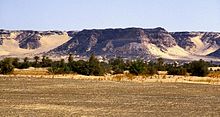
Hausa kingdoms (mid-14th century – 1808)
Main article: Hausa KingdomsBetween the Niger River and Lake Chad lay Hausa kingdoms and fertile areas. These kingdoms flourished from the mid-14th century up until the early 19th century, when they were conquered by Usman dan Fodio, founder of the Sokoto Empire. The Hausa kingdoms were not a compact entity but several federations of kingdoms more or less independent of one other. Their organization was somewhat democratic: the Hausa kings were elected by the notables of the country and could be removed by them.
The Hausa Kingdoms began as seven states founded according to the Bayajidda legend by the six sons of Bawo. Bawo was the unique son of the hausa queen Daurama and Bayajidda or (Abu Yazid by certain Nigerien historians) who came from Baghdad. The seven original hausa states were: Daoura (state of queen Daurama), Kano, Rano, Zaria, Gobir, Katsena and Biram.
Mali Empire
Main article: Mali EmpireThe Mali Empire was a Mandinka empire founded by Sundiata Keita circa 1230 that existed up to 1600. At its peak circa 1350, the empire extended as far west as Senegal and Guinee Conakry and as far east as western Niger.
Kanem-Bornu Empire
Main article: Kanem-Bornu EmpireThe Kanem-Bornu Empire was an empire that existed in modern-day Chad, Nigeria, Cameroon, Niger and Libya. The empire first existed and prospered as the Kanem Empire as early as the 9th century and later as the Kingdom of Bornu until 1900.
French Niger (1900–58)
| This section does not cite any sources. Please help improve this section by adding citations to reliable sources. Unsourced material may be challenged and removed. (October 2016) (Learn how and when to remove this message) |
In the 19th century, contact with Europe began with the first European explorers—notably Monteil (French) and Barth (German)—to travel to Niger.
Following the 1885 Berlin conference during which colonial powers outlined the division of Africa into colonial spheres, French military efforts to conquer existing African states were intensified in all French colonies including Niger. This included several military expeditions including the Voulet Chanoine Mission, which became notorious for pillaging, looting, raping and killing many local civilians on its passage. On 8 May 1899, in retaliation for the resistance of queen Sarraounia, captain Voulet and his men murdered all the inhabitants of the village of Birni-N'Konni in what is regarded as one of the worst massacres in French colonial history. French military expeditions met great resistance from several ethnic groups, especially Hausa and Tuareg groups. The most notable Tuareg revolt was the Kaocen Revolt. The French authorities also abolished the widespread slavery among Tuareg communities.
By 1922, all resistance to colonial rule was eliminated and Niger became a French colony. Niger's colonial history and development parallel that of other French West African territories. France administered her West African colonies through a governor general at Dakar, Senegal, and governors in the individual territories, including Niger. In addition to conferring a limited form of French citizenship on the inhabitants of the territories, the 1946 French constitution provided for decentralization of power and limited participation in political life for local advisory assemblies.
The end of the colonial era was characterized by a transformation of the political environment in French West Africa and Niger. The Nigerien Progressive Party, the Nigerien section of the African Democratic Rally Party, founded in May 1946, united various tendencies of Nigerien people in the movement for national independence. In alliance with progressive French elements and other independence African movements, the movements acquired the suppression of forced labor and arbitrary requisitions as well as legal equality between the African and the French citizens.
Independence (1958)
Following the Overseas Reform Act (Loi Cadre) of 23 July 1956 and the establishment of the Fifth French Republic on 4 December 1958, Niger became an autonomous state within the French Community. On 18 December 1958, the Republic of Niger was officially created with Hamani Diori as the head of the Counsel of Ministers of the Republic of Niger. On 11 July 1960, Niger decided to leave the French Community and acquired full independence on 3 August 1960 with Diori as its first president.

For its first fourteen years as an independent state, Niger was run by a single-party civilian regime under the presidency of Diori. In 1974, a combination of devastating drought and accusations of rampant corruption resulted in a coup d'état that overthrew the Diori regime.
First military regime: The Supreme Military Council and Second Republic 1974–1991
Col. Seyni Kountché and a small military group under the name of Supreme Military Council deposed Diori in April 1974, following a military coup, the first of many in the post-colonial history of Niger. President Kountché ruled the country until his death in 1987.
The first action of the Kountché military government was to address the food crisis which was one of the catalysts of the military coup. While political prisoners of the Diori regime were released after the coup and the country was stabilized, political and individual freedom deteriorated in general during this period. Political parties were banned. Several attempted coups (1975, 1976 and 1983) were thwarted and authors and associates were severely punished.
Despite the restriction in freedom, the country enjoyed improved economic development with the creation of new companies, the construction of major infrastructure (building and new roads, schools, health centers) and minimal corruption in government agencies, which Kountché did not hesitate to punish severely.
This economic development was helped by the uranium boom as well as optimal usage of public funds. Kountché was succeeded by his Chief of Staff, Col. Ali Saibou, who was confirmed as Chief of the Supreme Military Council on 14 November 1987, four days after Kountché's death. He introduced political reforms and drafted a new constitution, with the creation of a single party. He went on to rule the country as the Chief of the Supreme Military Council.
The 1989 referendum led to the adoption a new constitution and the creation of the Second Republic of Niger. General Saibou became the first president of the Second Republic after winning the presidential election on 10 December 1989. His presidency started during the Second Republic largely following his efforts at the end of the previous military regime with attempts at normalizing the political situation in the country with the release of political prisoners, liberalization of laws and policies.
President Saibou's efforts to control political reforms failed in the face of trade union and student demands to institute a multi-party democratic system. On 9 February 1990, a violently repressed student march led to the death of three students, which led to increased national and international pressure for a National Conference. The Saibou regime acquiesced to these demands by the end of 1990.
National Conference and Third Republic 1991–1997
The National Sovereign Conference of 1991 marked a turning point in the post-independence era of Niger and brought about multi-party democracy. From 29 July to 3 November, a national conference gathered all fringes of society to examine the political, economic and social situation of the country and make recommendations for the future direction of the country. The conference was presided over by Prof. André Salifou and developed a plan for a transitional government. This transitional government was installed in November 1991 to manage the affairs of state until the institutions of the Third Republic were put into place in April 1993.
While the economy deteriorated over the course of the transition, there were certain notable accomplishments, including the successful conduct of a constitutional referendum; the adoption of key legislation such as the electoral and rural codes; and the holding of several free, fair, and non-violent nationwide elections. Freedom of the press flourished, with the appearance of several new independent newspapers.
After the National Sovereign Conference, the transitional government drafted a new constitution that eliminated the previous single-party system of the 1989 Constitution and guaranteed more freedom. The new constitution was adopted by a referendum on 26 December 1992. Following this, presidential elections were held and Mahamane Ousmane became the first president of the Third Republic on 27 March 1993. The presidency of Mahamane Ousmane was characterized by political turbulence, with four government changes and early legislative elections called in 1995.
The parliamentary election forced cohabitation between a rival president and prime minister and ultimately led to governmental paralysis. As part of an initiative started under the National Sovereign Conference the government signed peace accords in April 1995 with Tuareg and Toubou groups that had been in rebellion since 1990. These groups claimed they lacked attention and resources from the central government. The government agreed to absorb some of the former rebels into the military and, with French assistance, to help others return to a productive civilian life.
Second military regime, Fourth Republic, third military regime 1997–1999
The government paralysis and the political tension was used as a motivation for a second military coup. On 27 January 1996, Col. Ibrahim Baré Maïnassara led a military coup that deposed President Ousmane and ended the Third Republic. Col. Maïnassara created the National Salvation Council composed of military officials, which he headed. The Council carried out a six-month transition period during which a new constitution was drafted and adopted on 12 May 1996.
Presidential campaigns were organized in the months that followed. General Maïnassara entered the campaign as an independent candidate and won the election on 8 July 1996. The elections were viewed nationally and internationally as irregular since the electoral commission was replaced during the campaign.
Ibrahim Baré Maïnassara became the first president of the Fourth Republic. His efforts to justify questionable elections failed to convince donors to restore multilateral and bilateral economic assistance; a desperate Maïnassara ignored an international embargo against Libya and sought Libyan funds to aid Niger's economy. In repeated violations of basic civil liberties by the regime, opposition leaders were imprisoned and journalists often arrested, and deported by an unofficial militia composed of police and military.
On 9 April 1999, Maïnassara was assassinated during a military coup led by Maj. Daouda Malam Wanké, who established a transitional National Reconciliation Council to oversee the drafting of a constitution for the Fifth Republic with a French-style semi-presidential system. The new constitution was adopted on 9 August 1999 and was followed by presidential and legislative elections in October and November of the same year. The elections were generally found to be free and fair by international observers. Wanké withdrew himself from government affairs after the new and democratically elected president was sworn in office.
Fifth republic 1999–2009
After winning the election in November 1999, President Tandja Mamadou was sworn in office on 22 December 1999 as the first president of the Fifth Republic. The first mandate of Tandja Mamadou brought about many administrative and economic reforms that had been halted due to the military coups since the Third Republic. In August 2002, serious unrest within military camps occurred in Niamey, Diffa, and Nguigmi, but the government was able to restore order within several days. On 24 July 2004, the first municipal elections in the history of Niger were held to elect local representatives, previously appointed by the government. These elections were followed by presidential elections. President Tandja Mamadou was re-elected for a second term, thus becoming the first president of the republic to win consecutive elections without being deposed by military coups. The legislative and executive configuration remained quite similar to that of the first term of the President: Hama Amadou was reappointed as Prime Minister and Mahamane Ousmane, the head of the CDS party, was re-elected as the President of the National Assembly (parliament) by his peers.
By 2007, the relationship between President Tandja Mamadou and his prime minister had deteriorated, leading to the replacement of the latter in June 2007 by Seyni Oumarou following a successful vote of no confidence at the Assembly. From 2007 to 2008, the Second Tuareg Rebellion took place in northern Niger, worsening economic prospects at a time of political limited progress. The political environment worsened in the following year as President Tandja Mamadou sought out to extend his presidency by modifying the constitution which limited presidential terms in Niger. Proponents of the extended presidency, rallied behind the Tazartche movement, were countered by opponents (anti-Tazartche) composed of opposition party militants and civil society activists.
Sixth republic and fourth military regime 2009–2010
In 2009, President Tandja Mamadou decided to organize a constitutional referendum seeking to extend his presidency claiming to respond to the desire of the people of Niger. Despite opposition from opposition political parties and against the decision of the Constitutional Court which ruled earlier that the referendum would be unconstitutional, President Tandja Mamadou modified and adopted a new constitution by referendum. It was declared illegal by the Constitutional Court but the President dissolved the Court and assumed emergency powers. The opposition boycotted the referendum and the new constitution was adopted with 92.5% of voters and a 68% turnout, according to official results. The adoption of the new constitution created a Sixth Republic, with a presidential system, as well as the suspension of the 1999 Constitution and a three-year interim government with Tandja Mamadou as president. Political and social unrest spiraled before, during and after the referendum project and ultimately led to a military coup in 2010 that ended the brief existence of the 6th Republic.
In a February 2010 coup d'état, a military junta led by captain Salou Djibo was established in response to Tandja's attempted extension of his political term by modifying the constitution. The Supreme Council for the Restoration of Democracy led by General Salou Djibo carried out a one-year transition plan, drafted a new constitution and held elections in 2011 that were judged internationally as free and fair.
Seventh republic 2010–present
Following the adoption of the newest constitution of 2010 and the presidential elections, Mahamadou Issoufou was elected as the first president of the Seventh Republic.
Geography, climate, and ecology
Main article: Geography of Niger
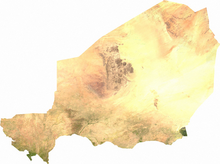
Niger is a landlocked nation in West Africa located along the border between the Sahara and Sub-Saharan regions. It borders Nigeria and Benin to the south, Burkina Faso and Mali to the west, Algeria and Libya to the north and Chad to the east.
Niger lies between latitudes 11° and 24°N, and longitudes 0° and 16°E. Niger's area is 1,267,000 square kilometres (489,191 sq mi) of which 300 square kilometres (116 sq mi) is water. This makes it slightly less than twice the size of France, and the world's twenty-second largest country.
Niger borders seven countries and has a total perimeter of 5,697 kilometres (3,540 mi). The longest border is with Nigeria to the south (1,497 km or 930 mi). This is followed by Chad to the east, at 1,175 km (730 mi), Algeria to the north-northwest (956 km or 594 mi), and Mali at 821 km (510 mi). Niger also has small borders in its far southwest with Burkina Faso at 628 km (390 mi) and Benin at 266 km (165 mi) and to the north-northeast Libya at 354 km (220 mi).
The lowest point is the Niger River, with an elevation of 200 metres (656 ft). The highest point is Mont Idoukal-n-Taghès in the Aïr Mountains at 2,022 m (6,634 ft).
Climate

Niger's subtropical climate is mainly very hot and very dry, with much desert area. In the extreme south there is a tropical climate on the edges of the Niger River basin. The terrain is predominantly desert plains and sand dunes, with flat to rolling savanna in the south and hills in the north.
Environment
Further information: Wildlife of Niger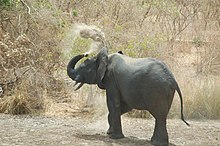
The north of Niger is covered by large deserts and semi deserts. The typical mammal fauna consists of Addax antelopes, Scimitar-horned oryx, gazelles and in mountains Barbary sheep. One of the largest reserves of the world, the Aïr and Ténéré National Nature Reserve, was founded in the northern parts of the Niger to protect these rare species.
The southern parts of Niger are naturally dominated savannahs. The W National Park, situated in the bordering area to Burkina Faso and Benin, belongs to one of the most important areas for wildlife in Western Africa, which is called the WAP (W–Arli–Pendjari) Complex. It has the most important population of the rare West African lion and one of the last populations of the Northwest African cheetah.
Other wildlife includes elephants, buffaloes, roan antelopes, kob antelopes and warthogs. The West African giraffe is currently not found in the W National Park, but further north in Niger, where it has its last relict population.
Environmental issues in Niger include destructive farming practices as a result of population pressure. Illegal hunting, bush fires in some areas and human encroachment upon the flood plains of the Niger River for paddy cultivation are environmental issues. Dams constructed on the Niger River in the neighboring countries of Mali and Guinea and also within Niger itself are also cited as a reason for a reduction of water flow in the Niger River—which has a direct effect upon the environment. A lack of adequate staff to guard wildlife in the parks and reserves is another factor cited for loss of wildlife.
Governance and politics
Main articles: Politics of Niger and Government of Niger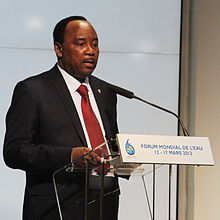
Niger's new constitution was approved on 31 October 2010. It restored the semi-presidential system of government of the 1999 constitution (Fifth Republic) in which the president of the republic, elected by universal suffrage for a five-year term, and a prime minister named by the president share executive power.
As a reflection of Niger's increasing population, the unicameral National Assembly was expanded in 2004 to 113 deputies elected for a five-year term under a majority system of representation. Political parties must attain at least 5 percent of the vote in order to gain a seat in the legislature.
The constitution also provides for the popular election of municipal and local officials, and the first-ever successful municipal elections took place on 24 July 2004. The National Assembly passed in June 2002 a series of decentralization bills. As a first step, administrative powers will be distributed among 265 communes (local councils); in later stages, regions and departments will be established as decentralized entities. A new electoral code was adopted to reflect the decentralization context. The country is currently divided into 8 regions, which are subdivided into 36 districts (departments). The chief administrator (Governor) in each department is appointed by the government and functions primarily as the local agent of the central authorities.
On 26 May 2009, President Tandja dissolved parliament after the country's constitutional court ruled against plans to hold a referendum on whether to allow him a third term in office. According to the constitution, a new parliament was elected within three months. This began a political struggle between Tandja, trying to extend his term-limited authority beyond 2009 through the establishment of a Sixth Republic, and his opponents who demanded that he step down at the end of his second term in December 2009. See 2009 Nigerien constitutional crisis. The military took over the country and President Tandja was put in prison, charged with corruption.
The military kept their promise to return the country to democratic civilian rule. A constitutional referendum and national elections were held. A presidential election was held on 31 January 2011, but as no clear winner emerged, run-off elections were held on 12 March 2011. Mahamadou Issoufou of the Nigerien Party for Democracy and Socialism was elected president. A parliamentary election was held at the same time.
Foreign relations

Niger pursues a moderate foreign policy and maintains friendly relations with the West and the Islamic world as well as non-aligned countries. It belongs to the UN and its main specialized agencies and in 1980–81 served on the UN Security Council. Niger maintains a special relationship with former colonial power France and has close relations with its West African neighbors.
It is a charter member of the African Union and the West African Monetary Union and also belongs to the Niger Basin Authority and Lake Chad Basin Commission, the Economic Community of West African States, the Non-Aligned Movement, the Organisation of Islamic Cooperation and the Organization for the Harmonization of Business Law in Africa (OHADA). The westernmost regions of Niger are joined with contiguous regions of Mali and Burkina Faso under the Liptako-Gourma Authority.
The border dispute with Benin, inherited from colonial times and concerning inter alia Lété Island in the Niger River, was solved by the International Court of Justice in 2005 to Niger's advantage.
Government finance
Government finance is derived revenue exports (Mining, oil and agricultural exports) as well as various forms of taxes collected by the government. In the past, foreign aid has contributed to large percentages of the budget. In 2013, Niger's government has adopted a zero-deficit budget of 1.279 trillion CFA francs ($2.53 billion) which is claimed to balance revenues and expenditures by an 11% reduction in the budget from the previous year.
The 2014 budget was 1.867 trillion CFA which is distributed as follows according to: public debt (76,703,692,000 CFA), personnel expenditures (210,979,633,960 CFA), operating expenditures (128,988,777,711 CFA); subsidies and transfers: 308,379,641,366 CFA) and Investment (1,142,513,658,712 CFA).
Foreign aid
The importance of external support for Niger's development is demonstrated by the fact that about 45% of the government's FY 2002 budget, including 80% of its capital budget, derives from donor resources. The most important donors in Niger are France, the European Union, the World Bank, the International Monetary Fund, and various United Nations agencies (UNDP, UNICEF, FAO, World Food Program, and United Nations Population Fund).
Other principal donors include the United States, Belgium, Germany, Switzerland, Canada, and Saudi Arabia. While USAID does not have an office in Niger, the United States is a major donor, contributing nearly $10 million each year to Niger's development. The U.S. also is a major partner in policy coordination in such areas as food security and HIV/AIDS.
Judicial system
Main article: Judiciary of NigerThe current Judiciary of Niger was established with the creation of the Fourth Republic in 1999. The constitution of December 1992 was revised by national referendum on 12 May 1996 and, again, by referendum, revised to the current version on 18 July 1999. It is based on the Code Napoleon "Inquisitorial system", established in Niger during French colonial rule and the 1960 Constitution of Niger. The Court of Appeals reviews questions of fact and law, while the Supreme Court reviews application of the law and constitutional questions. The High Court of Justice (HCJ) deals with cases involving senior government officials. The justice system also includes civil criminal courts, customary courts, traditional mediation, and a military court. The military court provides the same rights as civil criminal courts; however, customary courts do not. The military court cannot try civilians.
Law enforcement
Main article: Law enforcement in NigerLaw enforcement in Niger is the responsibility of the Ministry of Defense through the National Gendarmerie and the Ministry of the Interior through the National Police and the National Guard. The National Police is primarily responsible for law enforcement in urban areas. Outside big cities and in rural areas, this responsibility falls on the National Gendarmerie and the National Guard.
Military
Further information: Niger Armed ForcesThe Niger Armed Forces (Forces armées nigériennes) are the military and paramilitary forces of Niger, under the president as supreme commander. They consist of the Niger Army (Armée de Terre), the Niger Air Force (Armée de l'Air) and the auxiliary paramilitary forces, such as the National Gendarmerie (Gendarmerie nationale) and the National Guard (Garde Nationale). Both paramilitary forces are trained in military fashion and have some military responsibilities in wartime. In peace time their duties are mostly policing duties.
The armed forces are composed of approximately 12,900 personnel, including 3,700 gendarmes, 3200 national guards, 300 air force personnel, and 6,000 army personnel. The armed forces of Niger have been involved several military coups over the years with the most recent in 2010. Niger's armed forces have a long history of military cooperation with France and the United States. As of 2013, Niamey is home to a U.S. drone base.
Administrative divisions
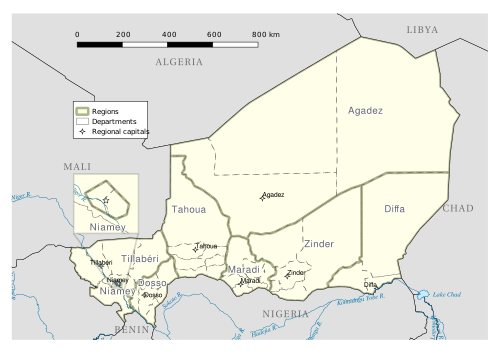
Niger is divided into 7 Regions and one capital district. These Regions are subdivided into 36 departments. The 36 Departments are currently broken down into Communes of varying types. As of 2006 there were 265 communes, including communes urbaines (Urban Communes: as subdivisions of major cities), communes rurales (Rural Communes), in sparsely populated areas and postes administratifs (Administrative Posts) for largely uninhabited desert areas or military zones.
Rural communes may contain official villages and settlements, while Urban Communes are divided into quarters. Niger subvisions were renamed in 2002, in the implementation of a decentralisation project, first begun in 1998. Previously, Niger was divided into 7 Departments, 36 Arrondissements, and Communes. These subdivisions were administered by officials appointed by the national government. These offices will be replaced in the future by democratically elected councils at each level.
The pre-2002 departments (renamed as regions) and capital district are:
- Agadez Region
- Diffa Region
- Dosso Region
- Maradi Region
- Tahoua Region
- Tillabéri Region
- Zinder Region
- Niamey (capital district)
Largest cities and towns
Template:Largest cities of Niger
Economy
Main article: Economy of Niger
The economy of Niger centers on subsistence crops, livestock, and some of the world's largest uranium deposits. Drought cycles, desertification, a 2.9% population growth rate, and the drop in world demand for uranium have undercut the economy.
Niger shares a common currency, the CFA franc, and a common central bank, the Central Bank of West African States (BCEAO), with seven other members of the West African Monetary Union. Niger is also a member of the Organization for the Harmonization of Business Law in Africa (OHADA).
In December 2000, Niger qualified for enhanced debt relief under the International Monetary Fund program for Heavily Indebted Poor Countries (HIPC) and concluded an agreement with the Fund for Poverty Reduction and Growth Facility (PRGF). Debt relief provided under the enhanced HIPC initiative significantly reduces Niger's annual debt service obligations, freeing funds for expenditures on basic health care, primary education, HIV/AIDS prevention, rural infrastructure, and other programs geared at poverty reduction.
In December 2005, it was announced that Niger had received 100% multilateral debt relief from the IMF, which translates into the forgiveness of approximately $86 million USD in debts to the IMF, excluding the remaining assistance under HIPC. Nearly half of the government's budget is derived from foreign donor resources. Future growth may be sustained by exploitation of oil, gold, coal, and other mineral resources. Uranium prices have recovered somewhat in the last few years. A drought and locust infestation in 2005 led to food shortages for as many as 2.5 million Nigeriens.
Economic sectors
Agriculture
Main article: Agriculture in Niger
The agricultural economy is based largely upon internal markets, subsistence agriculture, and the export of raw commodities: foodstuffs and cattle to neighbors. Foreign exchange earnings from livestock, although difficult to quantify, are considered the second source of export revenue behind mining and oil exports. Actual exports far exceed official statistics, which often fail to detect large herds of animals informally crossing into Nigeria. Some hides and skins are exported, and some are transformed into handicrafts.
Niger's agricultural and livestock sectors are the mainstay of all but 18% of the population. 14% of Niger's GDP is generated by livestock production (camels, goats, sheep and cattle), said to support 29% of the population. Thus 53% of the population is actively involved in crop production. The 15% of Niger's land that is arable is found mainly along its southern border with Nigeria.
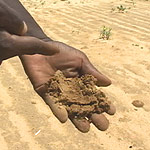
In these areas, Pearl millet, sorghum, and cassava are the principal rain-fed subsistence crops. Irrigated rice for internal consumption is grown in parts of the Niger River valley in the west. While expensive, it has, since the devaluation of the CFA franc, sold for below the price of imported rice, encouraging additional production. Cowpeas and onions are grown for commercial export, as are small quantities of garlic, peppers, potatoes, and wheat. Oasis farming in small patches of the north of the country produces onions, dates, and some market vegetables for export.
But for the most part, rural residents engaged in crop tending are clustered in the south centre and south west of the nation, in those areas (the Sahel) which can expect to receive between 300 to 600 mm (12 to 24 in) of rainfall annually. A small area in the southern tip of the nation, surrounding Gaya can expect to receive 700 to 900 mm (28 to 35 in) or rainfall. Northern areas which support crops, such as the southern portions of the Aïr Massif and the Kaouar oasis, rely upon oases and a slight increase in rainfall due to mountain effects. Large portions of the northwest and far east of the nation, while within the Sahara desert, see just enough seasonal rainfall to support semi-nomadic animal husbandry. The populations of these areas, mostly Tuareg, Wodaabe – Fula, and Toubou, travel south (a process called transhumance) to pasture and sell animals in the dry season, north into the Sahara in the brief rainy season.
Rainfall varies and when it is insufficient, Niger has difficulty feeding its population and must rely on grain purchases and food aid to meet food requirements. Rains, as in much of the Sahel, have been marked by annual variability. This has been especially true in the 20th century, with the most severe drought on record beginning in the late 1960s and lasting, with one break, well into the 1980s. The long-term effect of this, especially to pastoralist populations, remains in the 21st century, with those communities which rely upon cattle, sheep, and camels husbandry losing entire herds more than once during this period. Recent rains remain variable. For instance, the rains in 2000 were not good, while those in 2001 were plentiful and well distributed.
Soils that have become degraded, for example by intensive cereal production, cover 50 per cent of Niger's land. Laterite soils have a high clay content, which means they have higher Cation Exchange Capacity and water-holding capacity than sandy soils. If laterite soils become degraded, a hard crust can form on the surface, which hinders water infiltration and the emergence of seedlings. It is possible to rehabilitate such soils, using a system called the Bioreclamation of Degraded Lands.
This involves using indigenous water-harvesting methods (such as planting pits and trenches), applying animal and plant residues, and planting high-value fruit trees and indigenous vegetable crops that are tolerant of drought conditions. The International Crops Research Institute for the Semi-Arid Tropics (ICRISAT) has employed this system to rehabilitate degraded laterite soils in Niger and increase smallholder farmers' incomes. Trials have demonstrated that a 200 m (2,153 sq ft) plot can yield an income of around US$100, which is what men traditionally earn from millet production per hectare (10000m²). As women are often given degraded soils, using this practice has helped to improve livelihoods for women in Niger.
The Kandadji Dam on the Niger River, whose construction started in August 2008, is expected to improve agricultural production in the Tillaberi Department by providing water for the irrigation of 6,000 hectares initially and of 45,000 hectares by 2034.
Drought and food crisis
Main articles: Sahel drought, 2005–06 Niger food crisis, and 2010 Sahel droughtAs one of the Sahelian nations in West Africa, Niger has faced several droughts which led to food shortages and, in some cases, famines since its independence in 1963. This includes a series of droughts in the 1970s and 1980s and more recently in 2005–2006 and again in 2010. The existence of widespread famine in 2005–2006 was debated by the government of Niger as well some local NGOs.
Mining
Main articles: Mining in Niger and Coal mining in NigerThe Niger mining industry is the main source of national exports, of which uranium is the largest export. Niger has been a uranium exporter since the 1960s and has had substantial export earnings and rapid economic growth during the 1960s and 1970s. The persistent uranium price slump has brought lower revenues for Niger's uranium sector, although it still provides 72% of national export proceeds. When the uranium-led boom ended in the early 1980s the economy stagnated, and new investment since then has been limited. Niger's two uranium mines—SOMAIR's open pit mine and COMINAK's underground mine—are owned by a French-led consortium and operated by French company Areva.
As of 2007, many licences have been sold to other companies from countries such as India, China, Canada and Australia in order to exploit new deposits. In 2013, the government of Niger sought to increase its uranium revenue by subjecting the two mining companies to a 2006 Mining Law. The government argued that the application of the new law will balance an otherwise unfavorable partnership between the government and Areva. The company resisted the application of the new law that it feared would jeopardize the financial health of the companies, citing declining market uranium prices and unfavorable market conditions. In 2014, following nearly a year long negotiation with the government of Niger, Areva agreed to the application of 2006 Mining Law of Niger, which would increase the government's uranium revenues from 5 to 12%.

In addition to uranium, exploitable deposits of gold are known to exist in Niger in the region between the Niger River and the border with Burkina Faso. In 2004, the first Nigerien gold ingot was produced from the Samira Hill Gold Mine, in Tera Department. The Samira Hill Gold Mine thus became the first commercial gold production in the country. The reserves at the location were estimated at 10,073,626 tons at an average grade of 2.21 grams (0.078 oz) per ton from which 19,200 kilograms (42,300 lb) will be recovered over a six-year mine life. Other gold deposits are believed to be in nearby areas known as the "Samira Horizon", which is located between Gotheye and Ouallam.
SONICHAR (Société Nigerienne de Charbon) in Tchirozerine (north of Agadez) extracts coal from an open pit and fuels an electricity generating plant that supplies energy to the uranium mines. Based on 2012 reports by the government of Niger, 246016 tons of coal were extracted by SONICHAR in 2011. There are additional coal deposits to the south and west that are of a higher quality and may be exploitable. Substantial deposits of phosphates, coal, iron, limestone, and gypsum have also been found in Niger.
Oil
Main article: Petroleum industry in Niger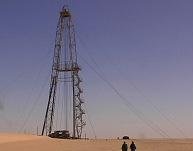
The history of oil prospecting and discovery goes back to the independence era with the first discovery of Tintouma oil field in Madama in 1975. It is the Agadem basin that has attracted much attention since 1970 with Texaco and then Esso prospecting in the basin until 1980. Exploration permits on the same basin were held successively by Elf Aquitaine (1980–1985), Esso-Elf (1985–1998), Esso (1998–2002) and Esso-Petronas (2002–2006). While the reserves were estimated at 324 millions barrels for oil and 10 billion m for gas, Esso-Petronas relinquished the permit because it deemed the quantities too small for production.
With the sudden increase in oil price, this assessment was no longer true by 2008. the government transferred the Agadem block rights to CNPC. Niger announced that in exchange for the US$5 billion investment, the Chinese company would build wells, 11 of which would open by 2012, a 20,000-barrel-per-day (3,200 m/d) refinery near Zinder and a pipeline out of the nation. The government estimates the area has reserves of 324 million barrels (51,500,000 m), and is seeking further oil in the Tenere Desert and near Bilma. Niger began producing its first barrels of oil in 2011.
Growth rates
The economic competitiveness created by the January 1994 devaluation of the Communauté Financière Africaine (CFA) franc contributed to an annual average economic growth of 3.5% throughout the mid-1990s. But the economy stagnated due to the sharp reduction in foreign aid in 1999 (which gradually resumed in 2000) and poor rains in 2000. Reflecting the importance of the agricultural sector, the return of good rains was the primary factor underlying economic growth of 5.1% in 2000, 3.1% in 2001, 6.0% in 2002, and 3.0% in 2003.
In recent years, the Government of Niger drafted revisions to the investment code (1997 and 2000), petroleum code (1992), and mining code (1993), all with attractive terms for investors. The present government actively seeks foreign private investment and considers it key to restoring economic growth and development. With the assistance of the United Nations Development Programme (UNDP), it has undertaken a concerted effort to revitalize the private sector.

Economic reforms
In January 2000, Niger's newly elected government inherited serious financial and economic problems including a virtually empty treasury, past-due salaries (11 months of unpaid salaries) and scholarship payments, increased debt, reduced revenue performance, and lower public investment. In December 2000, Niger qualified for enhanced debt relief under the International Monetary Fund program for Highly Indebted Poor Countries and concluded an agreement with the Fund on a Poverty Reduction and Growth Facility (PRGF).
In addition to changes in the budgetary process and public finances, the new government has pursued economic restructuring towards the IMF promoted privatization model. This has included the privatization of water distribution and telecommunications and the removal of price protections for petroleum products, allowing prices to be set by world market prices. Further privatizations of public enterprises are in the works.
In its effort to comply with the IMF's Poverty Reduction and Growth Facility plan, the government is also taking action to reduce corruption and, as the result of a participatory process encompassing civil society, has devised a Poverty Reduction Strategy Plan that focuses on improving health, primary education, rural infrastructure, and judicial restructuring.
A long planned privatization of the Nigerien power company, NIGELEC, failed in 2001 and again in 2003 due to a lack of buyers. SONITEL, the nation's telephone operator which was separated from the post office and privatised in 2001, was renationalised in 2009. Critics have argued that the obligations to creditor institutions and governments have locked Niger into a process of trade liberalization that is harmful for small farmers and in particular, rural women.

Transportation infrastructure
Main article: Transport in Niger
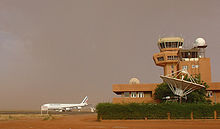
Transport is crucial to the economy and culture of this vast landlocked nation, with cities separated by huge uninhabited deserts, mountain ranges, and other natural features. Niger's transport system was little developed during the colonial period (1899–1960), relying upon animal transport, human transport, and limited river transport in the far south west and south east. No railways were constructed in the colonial period. Construction of a network of paved roads linking major cities began after the independence reaching its heights during the uranium boom in the 1970s and 1980s. Primary or paved road systems are limited to bigger cities or connection between major cities. Road connections or networks in rural areas are mostly unpaved, all-weather laterite surfaces to grated dirt or sand plowed roads with various degrees of maintenance. In 2012, there was 19,675 kilometres (12,225 mi) of road network throughout Niger, of which 4,225 kilometres (2,625 mi) were paved.
The Niger River, which crosses the southwestern part of the country, is unsuitable for river transport of any large scale, as it lacks depth for most of the year, and is broken by rapids at many spots. Camel caravan transport was historically important in the Sahara desert and Sahel regions which cover most of the north.
Air transport is mainly concentrated in Niamey. Niger's only international airport is Diori Hamani International Airport, is located in the capital, Niamey. Other airports in Niger include the Mano Dayak International Airport in Agadez city and Zinder Airport in Zinder city but as of January 2015, they were not regularly serviced by any carriers.
In 2014, construction for the railway extension connecting Niamey (Niger) to Cotonou via Parakou (Benin) began and is expected to be completed by 2016. It includes the construction of 574 kilometres (357 mi) new railway from Niamey to connect to the existing line in Parakou (Benin). Besides Niamey, the railway line will go through Dosso city and Gaya.
Society
Demographics
Main article: Demographics of Niger
As of 2021, the population of Niger was 25,252,722. Expanding from a population of 1.7 million in 1960, Niger's population has rapidly increased with a current growth rate of 3.3% (7.1 children per mother).
This growth rate is one of the highest in the world and is a source of concern for the government and international agencies. The population is predominantly young, with 49.2% under 15 years old and 2.7% over 65 years, and predominantly rural with only 21% living in urban areas.
A 2005 study stated that over 800,000 people (nearly 8 per cent of the population) in Niger are enslaved.
Ethnic groups
Main articles: Hausa people, Zarma people, Tuareg people, Fula people, Kanuri people, Tubu people, Diffa Arabs, and Gurma peopleNiger has a wide variety of ethnic groups as in most West African countries. The ethnic makeup of Niger is as follows: Hausa (53.0%), Zarma-Sonrai (21.2%), Tuareg (10.4%), Fula (Template:Lang-fr; Template:Lang-ff) (9.9%), Kanuri Manga (4.4%), Tubu (0.4%), Arab (0.3%), Gourmantche (0.3%), other (0.2%).
Languages
Main article: Languages of NigerFrench, inherited from the colonial period, is the official language. It is spoken mainly as a second language by people who have received a formal western education and serves as the administrative language. Niger has been a member of the Organisation Internationale de la Francophonie since 1970.
Niger has ten official national languages, namely Arabic, Buduma, Fulfulde, Gourmanchéma, Hausa, Kanuri, Zarma & Songhai, Tamasheq, Tassawaq, Tebu. Each is spoken as a first language primarily by the ethnic group with which it is associated. Hausa and Zarma-Sonrai, the two most spoken languages, are widely spoken throughout the country as first or second languages.
Largest cities
Further information: List of cities in NigerReligion
Main article: Religion in Niger| Religion in Niger (estimates round to 80%) | ||||
|---|---|---|---|---|
| religion | percent | |||
| Islam | 95% | |||
| Christianity & animism | 5% | |||
Niger is a secular country and separation of state and religion is guaranteed by Articles 3 and 175 of the 2010 Constitution, which dictate that future amendments or revisions may not modify the secular nature of the republic of Niger. Religious freedom is protected by Article 30 of the same constitution. Islam, widespread in the region since the 10th century, has greatly shaped the culture and morals of the people of Niger. Islam is the most dominant religion, practiced by 80% of the population.
The second most practiced religion is Christianity; this by less than 20% of the population. Christianity was established earlier in the country by missionaries during the French colonial years. Other urban Christian expatriate communities from Europe and West Africa are also presented. Religious persecution is rare in Niger which is ranked last (#50) on the World Watch List for severity of persecution that Christians face for actively pursuing their faith.
Islam
Main article: Islam in NigerApproximately 59 percent of Muslims in Niger are Sunni, 7 percent are Shi'a, 5% are Ahmadiyya and 20% Non-denominational. Islam was spread into what is now Niger beginning in the 15th century, by both the expansion of the Songhai Empire in the west, and the influence of the Trans-Saharan trade traveling from the Maghreb and Egypt. Tuareg expansion from the north, culminating in their seizure of the far eastern oases from the Kanem-Bornu Empire in the 17th centuries, spread distinctively Berber practices.
Both Zarma and Hausa areas were greatly influenced by the 18th and 19th century Fula led Sufi brotherhoods, most notably the Sokoto Caliphate (in today's Nigeria). Modern Muslim practice in Niger is often tied to the Tijaniya Sufi brotherhoods, although there are small minority groups tied to Hammallism and Nyassist Sufi orders in the west, and the Sanusiya in the far northeast.
A small center of followers of Salafi movement within Sunni Islam have appeared in the last thirty years, in the capital and in Maradi. These small groups, linked to similar groups in Jos, Nigeria, came to public prominence in the 1990s during a series of religious riots.
Despite this, Niger maintains a tradition as a secular state, protected by law. Interfaith relations are deemed very good, and the forms of Islam traditionally practiced in most of the country are marked by tolerance of other faiths and lack of restrictions on personal freedom. Divorce and polygyny are unremarkable, women are not secluded, and head coverings are not mandatory—they are often a rarity in urban areas. Alcohol, such as the locally produced Bière Niger, is sold openly in most of the country.
Animism
A small percentage of the population practices traditional indigenous religious beliefs. The numbers of Animist practitioners are a point of contention. As recently as the late 19th century, much of the south center of the nation was unreached by Islam, and the conversion of some rural areas has been only partial. There are still areas where animist based festivals and traditions (such as the Bori religion) are practiced by syncretic Muslim communities (in some Hausa areas as well as among some Toubou and Wodaabe pastoralists), as opposed to several small communities who maintain their pre-Islamic religion. These include the Hausa-speaking Maouri (or Azna, the Hausa word for "pagan") community in Dogondoutci in the south-southwest and the Kanuri speaking Manga near Zinder, both of whom practice variations of the pre-Islamic Hausa Maguzawa religion. There are also some tiny Boudouma and Songhay animist communities in the southwest.
Education
Main article: Education in Niger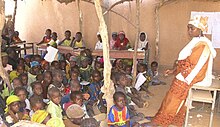
The literacy rate of Niger is among the lowest in the world; in 2005 it was estimated to be only 28.7% (42.9% male and 15.1% female). Primary education in Niger is compulsory for six years. The primary school enrollment and attendance rates are low, particularly for girls. In 1997, the gross primary enrollment rate was 29.3 percent, and in 1996, the net primary enrollment rate was 24.5 percent.
About 60 percent of children who finish primary schools are boys, as the majority of girls rarely attend school for more than a few years. Children are often forced to work rather than attend school, particularly during planting or harvest periods. Nomadic children in the north of the country often do not have access to schools.
Health
Main article: Health in NigerThe child mortality rate in Niger (deaths among children between the ages of 1 and 4) is high (248 per 1,000) due to generally poor health conditions and inadequate nutrition for most of the country's children. According to the organization Save the Children, Niger has the world's highest infant mortality rate.
Niger also has the highest fertility rate in the world (7.03 births per woman according to 2013 estimates); this means that nearly half (49%) of the Nigerien population is under age 15. Niger has the 11th highest maternal mortality rate in the world at 820 deaths/100,000 live births. There were 3 physicians and 22 nurses per 100,000 persons in 2006.
Culture
Main article: Culture of Niger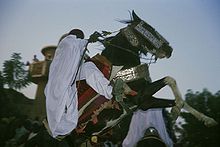
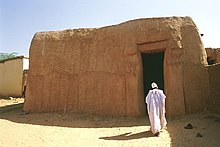
Nigerien culture is marked by variation, evidence of the cultural crossroads which French colonialism formed into a unified state from the beginning of the 20th century. What is now Niger was created from four distinct cultural areas in the pre-colonial era: the Zarma dominated Niger River valley in the southwest; the northern periphery of Hausaland, made mostly of those states which had resisted the Sokoto Caliphate, and ranged along the long southern border with Nigeria; the Lake Chad basin and Kaouar in the far east, populated by Kanuri farmers and Toubou pastoralists who had once been part of the Kanem-Bornu Empire; and the Tuareg nomads of the Aïr Mountains and Saharan desert in the vast north.
Each of these communities, along with smaller ethnic groups like the pastoral Wodaabe Fula, brought their own cultural traditions to the new state of Niger. While successive post-independence governments have tried to forge a shared national culture, this has been slow forming, in part because the major Nigerien communities have their own cultural histories, and in part because Nigerien ethnic groups such as the Hausa, Tuareg and Kanuri are but part of larger ethnic communities which cross borders introduced under colonialism.
Until the 1990s, government and politics was inordinately dominated by Niamey and the Zarma people of the surrounding region. At the same time the plurality of the population, in the Hausa borderlands between Birni-N'Konni and Maine-Soroa, have often looked culturally more to Hausaland in Nigeria than Niamey. Between 1996 and 2003, primary school attendance was around 30%, including 36% of males and only 25% of females. Additional education occurs through madrasas.
Festivals and cultural events
Guérewol festival
Main article: Guérewol
The Guérewol festival is a traditional Wodaabe cultural event that takes place in Abalak in Tahoua region or In'Gall in Agadez Region. It is an annual traditional courtship ritual practiced by the Wodaabe (Fula) people of Niger. During this ceremony, young men dressed in elaborate ornamentation and made up in traditional face painting gather in lines to dance and sing, vying for the attention of marriageable young women. The Guérewol festival is an internationally attraction and was featured in films and magazines as prominent as the National Geographic.
Cure Salée festival
Main article: Cure Salee"La Cure salée" (English: Salt Cure) is a yearly festival of Tuareg and Wodaabe nomads in In'Gall in Agadez Region traditionally to celebrate the end of the rainy season. For three days, the festival features a parade of Tuareg camel riders followed with camel and horse races, songs, dances, and storytelling.
Media
Main article: Media of NigerNiger began developing diverse media in the late 1990s. Prior to the Third Republic, Nigeriens only had access to tightly controlled state media. Now Niamey contains scores of newspapers and magazines; some, like Le Sahel, are government operated, while many are critical of the government. Radio is the most important medium, as television sets are beyond the buying power of many of the rural poor, and illiteracy prevents print media from becoming a mass medium.
In addition to the national and regional radio services of the state broadcaster ORTN, there are four privately owned radio networks which total more than 100 stations. Three of them—the Anfani Group, Sarounia and Tenere—are urban-based commercial-format FM networks in the major towns. There is also a network of over 80 community radio stations spread across all seven regions of the country, governed by the Comité de Pilotage de Radios de Proximité (CPRP), a civil society organisation. The independent-sector radio networks are collectively estimated by CPRP officials to cover some 7.6 million people, or about 73% of the population (2005).
Aside from Nigerien radio stations, the BBC's Hausa service is listened to on FM repeaters across wide parts of the country, particularly in the south, close to the border with Nigeria. Radio France Internationale also rebroadcasts in French through some of the commercial stations, via satellite. Tenere FM also runs a national independent television station of the same name.
Despite relative freedom at the national level, Nigerien journalists say they are often pressured by local authorities. The state ORTN network depends financially on the government, partly through a surcharge on electricity bills, and partly through direct subsidy. The sector is governed by the Conseil Supérieur de Communications, established as an independent body in the early 1990s, since 2007 headed by Daouda Diallo. International human rights groups have criticised the government since at least 1996 as using regulation and police to punish criticism of the state.
See also
- Outline of Niger
- Cinema of Niger
- Green Sahara
- LGBT rights in Niger
- List of African writers by country#Niger
- Music of Niger
- Telecommunications in Niger
- African Centre of Meteorological Application for Development
- Sahel-Benin Union
References
- ^ République du Niger, "Loi n° 2001-037 du 31 décembre 2001 fixant les modalités de promotion et de développement des langues nationales." L'aménagement linguistique dans le monde (accessed 21 September 2016)
- "Nigerien – definition of Nigerien in English from the Oxford Dictionaries". Retrieved 1 March 2018.
- ^ "Niger". International Monetary Fund. Retrieved 20 April 2012.
- World Bank GINI index, accessed on January 21, 2016.
- ^ "Human Development Report 2016" (PDF). United Nations Development Programme. 2016. p. 25. Retrieved 4 January 2018.
- Which side of the road do they drive on? Brian Lucas. August 2005. Retrieved 28 January 2009.
- ^ "ISO 3166". ISO Online Browsing Platform. Retrieved 12 May 2017.
- ^ "UNGEGN World Geographical Names". United Nations Statisticsc Division. 1 March 2017. Retrieved 12 May 2017.
- , How Do You Pronounce "Niger"? from Slate.com, retrieved 4 March 2012
- "Niger." The American Heritage® Dictionary of the English Language, Fourth Edition. 2003. Houghton Mifflin Company 22 February 2013 http://www.thefreedictionary.com/Niger
- ^ "World Population Prospects 2022". United Nations Department of Economic and Social Affairs, Population Division. Retrieved 17 July 2022.
- ^ "World Population Prospects 2022: Demographic indicators by region, subregion and country, annually for 1950-2100" (XSLX) ("Total Population, as of 1 July (thousands)"). United Nations Department of Economic and Social Affairs, Population Division. Retrieved 17 July 2022.
- "Population Explosion". The Economist. 16 August 2014. Retrieved 3 August 2015.
- Gwin, Peter. "Lost Tribes of the Green Sahara", National Geographic, September 2008.
- ^ Ancient cemetery found in 'green' Sahara Desert
- ^ – Niger
- ^ Boubou Hama and M Guilhem, "L’histoire du Niger, de l’Afrique et du Monde"; Edicef, Les royaumes Haoussa, pp. 104–112
- African Kingdoms African kingdoms – The Songhai Empire
- ^ Decalo, Samuel (1997). Historical Dictionary of the Niger (3rd ed.). Boston & Folkestone: Scarecrow Press. ISBN 0-8108-3136-8.
- Le coup d'etat de Kountche
- Kountché: 40 ans après son coup d'état
- "Abdourahmane Idrissa, Samuel Decalo" (2012). "Historical Dictionary of Niger". "Scarecrow Press". p. 421.
- Publications, USA International Business (2007). Niger Foreign Policy and Government Guide. Int'l Business Publications. ISBN 9781433036873.
{{cite book}}:|first1=has generic name (help) - ^ Geels, Jolijn. Niger. Bradt UK/Globe Pequot Press USA, 2006. ISBN 978-1-84162-152-4
- "Africa – Niger leader dissolves parliament". Al Jazeera English. 26 May 2009. Retrieved 3 May 2010.
- Ahmad, Romoke W. "West Africa: Ecowas, EU Say Niger Elections Satisfactory", Daily Trust (republished at AllAfrica.com), 3 February 2011.
- Saidou, Djibril. "Niger’s Presidential Election Heads to March Runoff", Bloomberg Businessweek, 4 February 2011.
- Look, Anne. "Niger Politicians Forge Alliances Before March Election", Voice of America, 14 February 2011.
- Niger government adopts $2.53 bln budget for 2013
- Niger budget 2014
- ^ Background Notes for Niger: January 2009 Bureau of African Affairs, United States State Department. Retrieved 26 February 2009. Portions of the "Economy" section are here used verbatim, as this document is in the public domain.
- Niger:Système judiciaire Archived 26 November 2008 at the Wayback Machine. NIGER Situation institutionnelle. Sory Baldé, CEAN, IEP-Université Montesquieu-Bordeaux IV (2007) Accessed 2009-04-13
- 2008 Human Rights Report: Niger in 2008 Country Reports on Human Rights Practices. United States Bureau of Democracy, Human Rights, and Labor. (25 February 2009) As a publication of the United States Federal Government, this report is in the Public Domain. Portions of it may be used here verbatim.
- "OHADA.com: The business law portal in Africa". Retrieved 22 March 2009.
- ^ Bio-reclamation – Converting degraded lateritic soils into productive land, Rural 21, March 2013.
- "Kandadji" Ecosystems Regeneration and Niger Valley Development Programme (KERNVDP), Detailed Population Resettlement Plan, Executive Summary, Republic of Niger, Prime Minister's Office, High Commission for Niger Valley / African Development Bank, February 2008, p. 3-4.
- When Endemic Malnutrition is Labeled as Famine Eden Foundation
- ^ "UPDATE 3-Areva signs uranium deal with Niger, delays new mine". Reuters. Retrieved 7 February 2015.
- ^ "Niger sets new terms in uranium ore deal with Areva". DW.DE. Retrieved 7 February 2015.
- Background Note:Niger, United States State Department, Bureau of Public Affairs: Electronic Information and Publications Office. Bureau of African Affairs. September 2008
- "– Coal Production and Utilization 2007–2011 Report P218" (PDF).
- ^ "Archived copy". Archived from the original on 14 July 2014. Retrieved 29 June 2014.
{{cite web}}: Unknown parameter|deadurl=ignored (|url-status=suggested) (help)CS1 maint: archived copy as title (link) Le Petrole Nigerien: D'Agadem a la Soraz - As refinery opens, Niger joins club of oil producers, Agence France-Presse. 28 November 2011.
- report by 3D → Trade – Human Rights – Equitable Economy, on Agriculture trade liberalization and women's rights.
- Reseau routier du Niger
- ^ Niger population explosion and development
- ^ , Niger's National Statistics Institute Report
- "The Shackles of Slavery in Niger". ABC News. 3 June 2005.
- "Born to be a slave in Niger". BBC News. 11 February 2005.
- "BBC World Service | Slavery Today". BBC. Retrieved 3 May 2010.
- Ethologue – Niger languages
- "Archived copy". Archived from the original on 18 June 2014. Retrieved 22 June 2014.
{{cite web}}: Unknown parameter|deadurl=ignored (|url-status=suggested) (help)CS1 maint: archived copy as title (link) Presidence du Niger - Population figures from citypopulation.de, citing (2001) Institut National de la Statistique du Niger.
- fallingrain.com.
- "Religion in Niger" (PDF). National Institut of Statistic of Niger. Retrieved 24 June 2014.
- "Niger". Association of Religion Data Archives. Retrieved 3 November 2012.
- "The World's Muslims: Unity and Diversity" (PDF). Pew Forum on Religious & Public life. 9 August 2012. Retrieved 2 June 2014.
- ^ International Religious Freedom Report 2007: Niger. United States Bureau of Democracy, Human Rights and Labor (14 September 2007). This article incorporates text from this source, which is in the public domain.
- ^ Decalo, James. Historical Dictionary of Niger. Scarecrow Press, Metuchen, New Jersey – London, 1979. ISBN 0-8108-1229-0. pp. 156–7, 193–4.
- Decalo (1997) p. 261–2, 158, 230.
- Ben Amara, Ramzi. "The Development of the Izala Movement in Nigeria: Its Split, Relationship to Sufis and Perception of Sharia Implementation". Research Summary (n.d.)
- Nigeria Christian / Muslim Conflict, GlobalSecurity.org (n.d.)
- Summary for Shedrack Best's Nigeria, The Islamist Challenge, the Nigerian 'Shiite' Movement, 1999 Archived 13 January 2009 at the Wayback Machine; conflict-prevention.net.
- International Religious Freedom Report 2001: Niger. United States Bureau of Democracy, Human Rights and Labor, 26 October 2001.
- t'Sas, Vincent. "Islam is thriving in impoverished Niger", Reuters, 6 December 1997.
- Imam, Ayesha M. Dossier 17: The Muslim Religious Right ('Fundamentalists') and Sexuality Archived 16 March 2009 at the Wayback Machine. WLUML, November 1997.
- "The World Factbook". Cia.gov. Retrieved 25 April 2014.
- ^ "Niger" Archived 5 December 2008 at the Wayback Machine. 2001 Findings on the Worst Forms of Child Labor. Bureau of International Labor Affairs, U.S. Department of Labor (2002). This article incorporates text from this source, which is in the public domain.
- Green, Jeff (10 May 2006). "U.S. has second worst newborn death rate in modern world, report says". CNN. Retrieved 3 May 2010.
- "The World Factbook". Cia.gov. Retrieved 25 April 2014.
- "The World Factbook". Cia.gov. Retrieved 25 April 2014.
- "Niger". Archived from the original on 23 November 2011. Retrieved 20 May 2012.
{{cite web}}: Unknown parameter|deadurl=ignored (|url-status=suggested) (help) - "At a glance: Niger". Archived from the original on 30 November 2009. Retrieved 22 June 2007.
{{cite web}}: Unknown parameter|deadurl=ignored (|url-status=suggested) (help) - SEMINAIRE-ATELIER DE FORMATION ET DE SENSIBILISATION "Mission de service public dans les entreprises de presse d’Etat et privée". Historical introduction to Press Laws, in conference proceedings, Organised by FIJ/SAINFO/LO-TCO CCOG. NIAMEY, June 2002.
- Media in Niger: the African Development Information Database Archived 13 December 2009 at the Wayback Machine.
- Medias Status Report: Niger Archived 4 March 2009 at the Wayback Machine. Summary document written for the African Media Partners Network. Guy-Michel Boluvi, Les Echos du Sahel Niamey, January 2001.
- ^ U.S. Department of State. Report on Human Rights Practices – Niger. 1993–1995 to 2006.
- Niger : Conseil de presse. Les journalistes refusent la mise sous tutelle Archived 10 May 2011 at the Wayback Machine. Ousseini Issa. Médi@ctions n°37, Institut PANOS Afrique de l'Ouest. March 2004.
- Attacks on the press: Niger 2006. Committee to Protect Journalists (2007). Retrieved 23 February 2009.
- Niger: Emergency legislation infringes non-derogable human rights Archived 11 February 2009 at the Wayback Machine. AMNESTY INTERNATIONAL Public Statement. AI Index: AFR 43/001/2007 (Public Document) Press Service Number: 181/07. 21 September 2007.
Sources
- Decalo, Samuel. Historical Dictionary of Niger, 3rd ed. (Scarecrow Press, 1997, ISBN 0-8108-3136-8) – a comprehensive collection of Niger topics
- CIA World Factbook (entry on Niger)
- US State Department "Niger". State.gov. 3 February 2010. Retrieved 3 May 2010. Note: This article contains material from the State Department website.
- Unicef Niger statistics
- Unesco manuscript on child work and schooling in Niger
External links
- Official website
- "Niger". The World Factbook (2025 ed.). Central Intelligence Agency.
- Niger from UCB Libraries GovPubs
- Template:Dmoz
- Niger profile from the BBC News
 Wikimedia Atlas of Niger
Wikimedia Atlas of Niger Niger travel guide from Wikivoyage
Niger travel guide from Wikivoyage- Key Development Forecasts for Niger from International Futures
Trade
| Niger articles | |||
|---|---|---|---|
| History |  | ||
| Geography | |||
| Politics | |||
| Economy | |||
| Culture | |||
| Countries and territories of Africa | |||||||||||
|---|---|---|---|---|---|---|---|---|---|---|---|
| Sovereign states |
| ||||||||||
| States with limited recognition | |||||||||||
| Dependent territories |
| ||||||||||
| African territories fully part of non-African states |
| ||||||||||
- Niger
- Saharan countries
- West African countries
- Economic Community of West African States
- French-speaking countries and territories
- Landlocked countries
- Least developed countries
- Member states of the African Union
- Member states of the Organisation of Islamic Cooperation
- Member states of the United Nations
- Republics
- States and territories established in 1960
- 1960 establishments in Africa
- 1960 disestablishments in France
- Countries in Africa